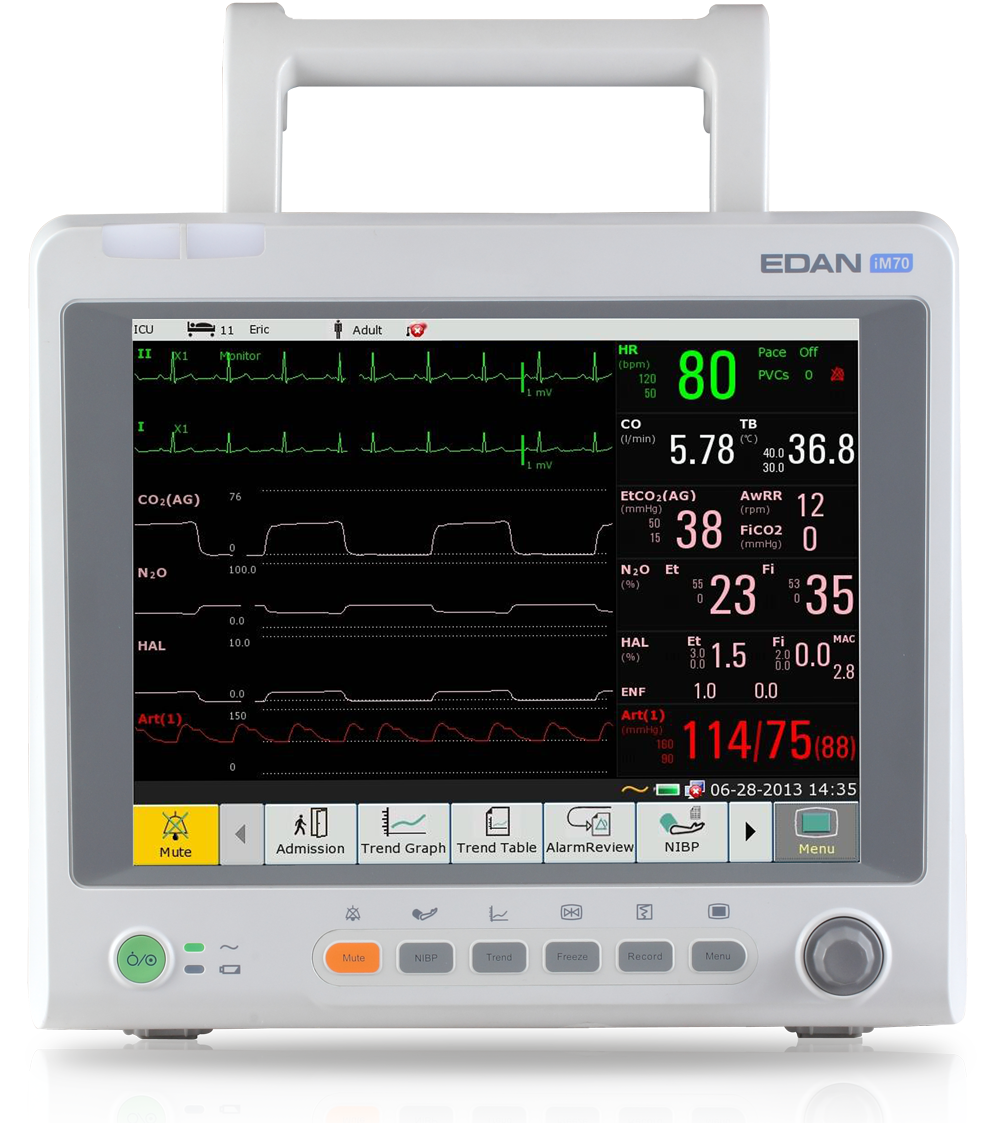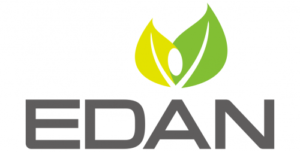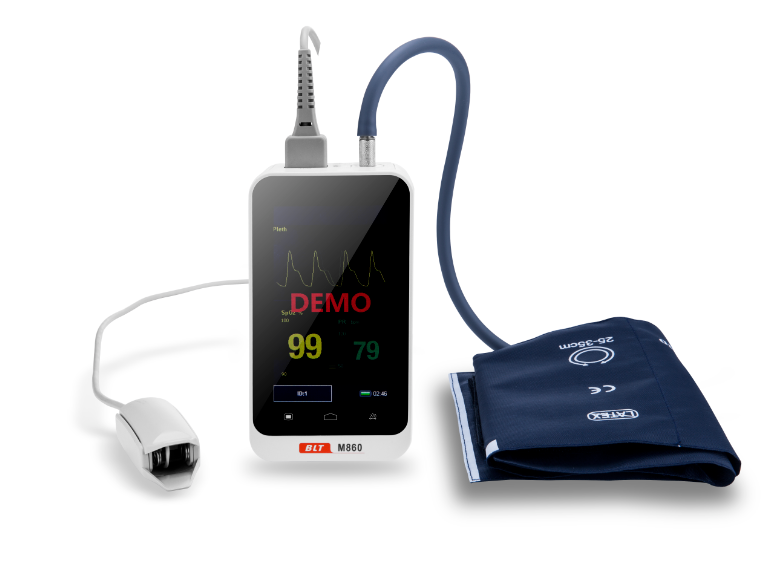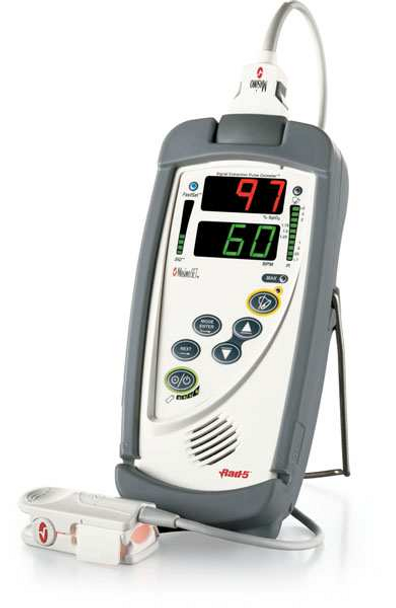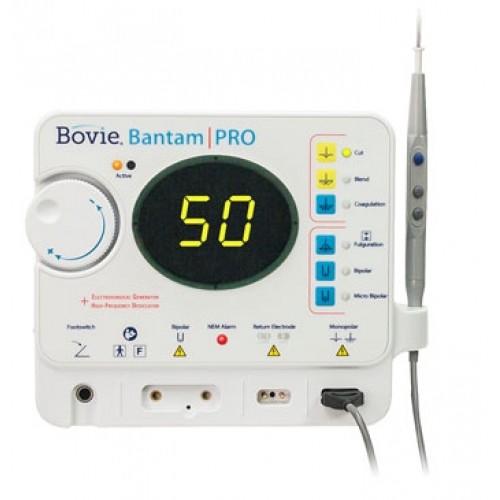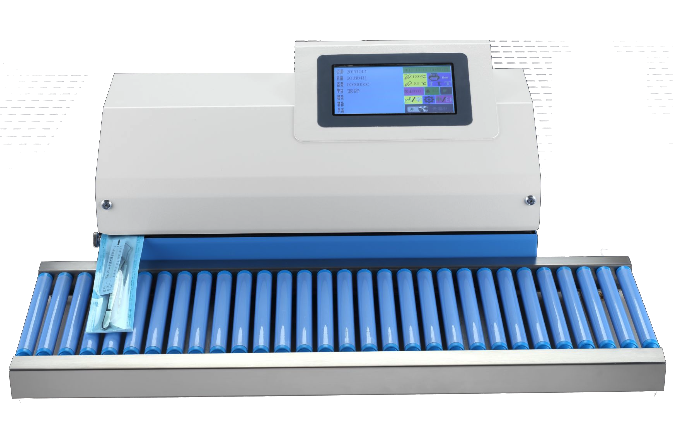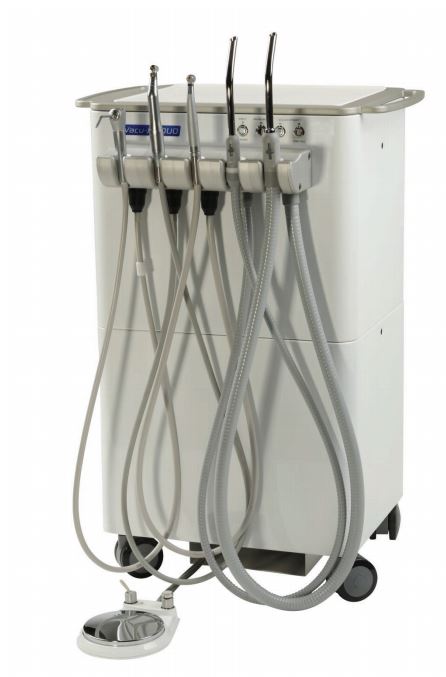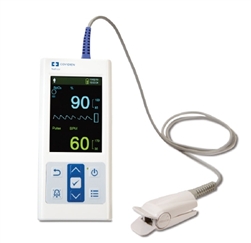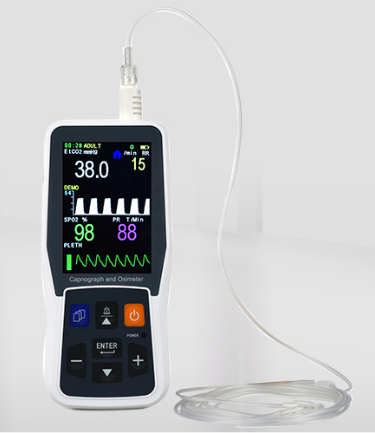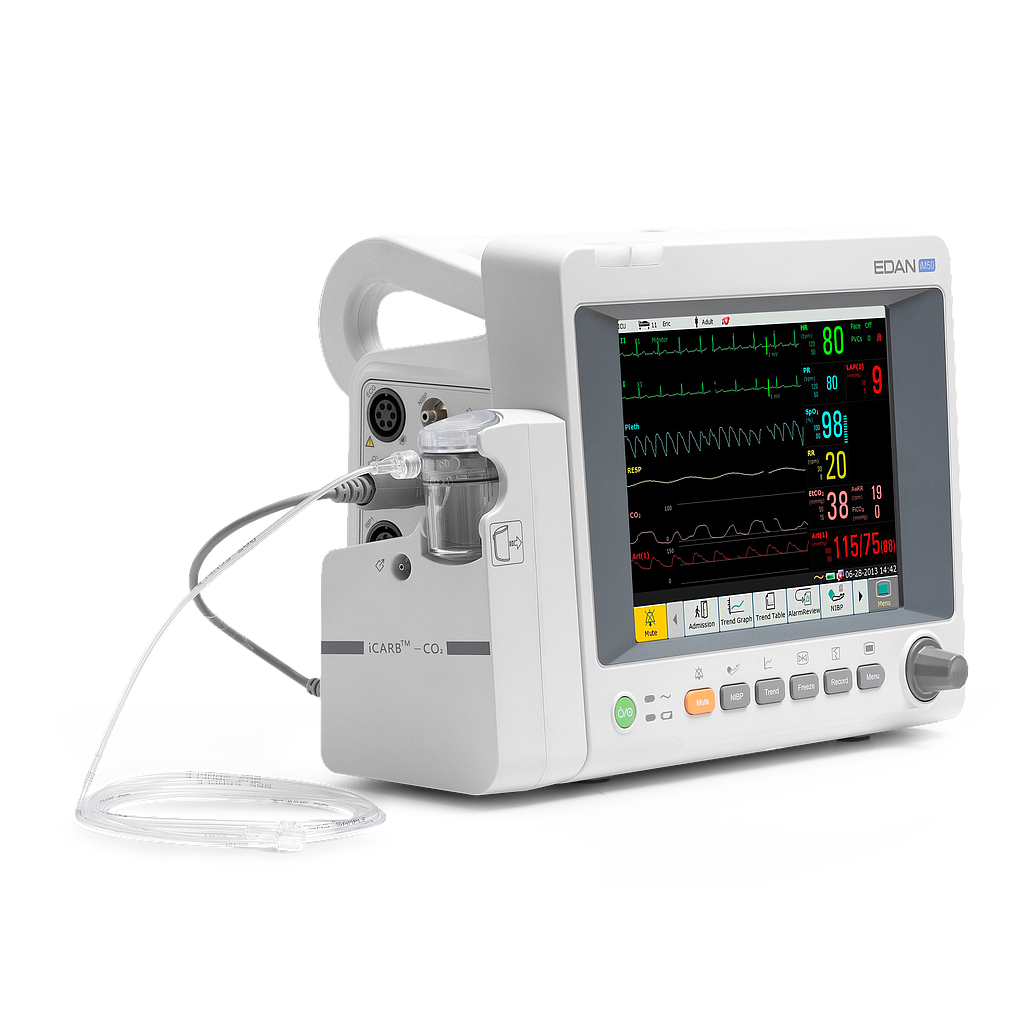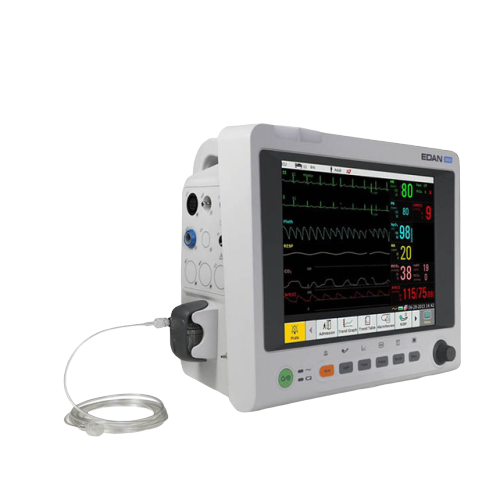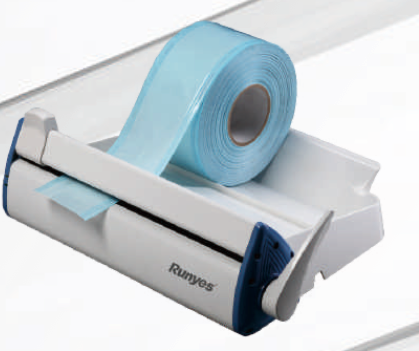EDAN iM70 Patient Monitor 12.1″ Touchscreen
The EDAN iM70 is the mid of the iM range, a larger screen for more detail and clarity of your waveforms. Options available
Kit Includes:
Wifi + Data Management Kit
Touch Screen
Printer
Sp02 Adult/Paed Accessories
NIBP Paed/Aduld/Large Adult
3/Lead ECG Cable
Skin Temp Probe
Please allow 2 – 3 weeks for delivery.
Description
EDAN iM70 Patient Monitor 12.1″ Touchscreen
Classification
Anti-electroshock type Class I equipment and internal powered equipment
Anti-electroshock degree ECG (RESP), TEMP, IBP, C.O., Quick Temp CF
SpO2, NIBP, CO2, AG BF
Ingress Protection IPX1
Disinfection/sterilization method Refer to Chapter Care and Cleaning for details.
Working system Continuous operation equipment
Compliant with Standards IEC 60601-1: 2005+A1 :2012; IEC 60601-1-2: 2014;
EN 60601-1: 2006+A1 :2013; EN 60601-1-2: 2015; IEC 60601-2-49: 2011
Physical Specifications
Poduct Size Weight (standard configuration, without battery)
iM50/M50 261 mm (W) 215 mm (H) 198 mm (D) < 3.6 kg
iM60 303 mm (W) 254 mm (H) 161 mm (D) < 3.8 kg
iM70 328 mm (W) 285 mm (H) 158 mm (D) < 4.5 kg
iM80/M80 370 mm (W) 320 mm (H) 175 mm (D) < 7 kg
Function Configuration
iM50/M50 Product Standard Configuration
ECG, RESP, TEMP, SpO2 (EDAN),
NIBP (EDAN)
MEWS, Neonatal Configuration,
RJ45 interface, USB interface,
VGA interface, SD card
Touchscreen
Optional Configuration
|Quick TEMP, SpO2 (Nellcor), IBP,
CO2 (EDAN), CO2 (Respironics)
Recorder, Wi-Fi
iM60 Product Standard Configuration
ECG, RESP, TEMP, SpO2 (EDAN),
NIBP (EDAN)
MEWS, Neonatal Configuration,
RJ45 interface, USB interface,
VGA interface, SD card
Touchscreen
Optional Configuration
SpO2 (Nellcor), NIBP (SunTech),
IBP, C.O., CO2 (EDAN), CO2 (Respironics)
Recorder, touchscreen, Wi-Fi
iM70 Product Standard Configuration
ECG, RESP, TEMP, SpO2 (EDAN),
NIBP (EDAN)
MEWS, Neonatal Configuration,
RJ45 interface, USB interface,
VGA interface, SD card
Touchscreen
Optional Configuration
SpO2 (Nellcor), NIBP (Omron),
NIBP (SunTech), IBP, C.O., CO2
(EDAN), CO2 (Respironics), AG
(Masimo)
Recorder, touchscreen, Wi-Fi
iM80/M80 Product Standard Configuration
ECG, RESP, TEMP, SpO2 (EDAN),
NIBP (EDAN)
MEWS, Neonatal Configuration,
RJ45 interface, USB interface,
VGA interface, SD card
Touchscreen
Optional Configuration
SpO2 (Nellcor), NIBP (Omron),
NIBP (SunTech), IBP, C.O., CO2
(EDAN), CO2 (Respironics), AG
(Masimo), AG (Dräger)
RS232 interface, recorder,
touchscreen, Wi-Fi
Environment Specification
The monitor may not meet the performance specifications given here if stored or used outside the specified temperature and humidity ranges. When the monitor and related products have differing environmental specifications, the effective range for the combined products is that range which is common to the specifications for all products.
Temperature:
Working +0 oC to +40 oC(32 ℉~104 ℉)
Transport and Storage -20 oC to +55 oC(-4 ℉~131 ℉)
Humidity
Working 15%RH ~ 95%RH (non-condensing)
Transport and Storage 15%RH ~ 95%RH (non-condensing)
Altitude
Working 86 kPa ~ 106 kPa
Transport and Storage 70 kPa ~ 106 kPa
Power Supply:
100 V-240 V~, 50 Hz/60 Hz
iM50/M50 Current=1.0 A-0.5 A; Fuse: T3.15AH, 250VP
iM80/M80 Current=1.4 A-0.7 A; Fuse: T3.15AH, 250VP
iM60/iM70 Current=1.4 A-0.7 A; Fuse: T3.15AH, 250VP
Display
A maximum of 13 waveforms
|One power LED/Two alarm LED/One charge LED
iM50/M50 Display screen: 8.4 inch color TFT, touch screen Res: 800X600
iM60 Display screen: 10.4 inch color TFT, touch screen Res: 809X600
iM70 Display screen: 12.1 inch color TFT, touch screen Res: 800X600
iM80/M80 Display screen: 15 inch color TFT, touch screen Res: 1024 Å~ 768
Battery Specification
Operating Time iM50/iM60iM70/M50
2500 mAh ≥ 3.5 h
5000 mAh ≥ 7 h
iM80/M80
One battery (5000 mAh) ≥ 6 h
Two batteries (2*5000 mAh) ≥ 12 h
Condition At 25±2 oC, with (a) new fully charged battery/batteries, EDAN module in use, continuous SpO2 measurement and NIBP automatic measurement mode at interval of 15 minutes, ECG/TEMP module connected, recording at interval of 10 minutes, brightness set to “1”.
Charge Time iM50/iM60/iM70/M50
2500 mAh ≤ 3.5 h, 100% charge ≤ 3.15 h, 90% charge 5000 mAh ≤ 6.5 h, 100% charge ≤ 5.85 h, 90% charge
iM80/M80 One battery (5000 mAh) ≤ 6.5 h, 100% charge ≤ 5.85 h, 90% charge
Two batteries (2*5000 mAh) ≤ 13 h, 100% charge ≤ 11.7 h, 90% charge
Recorder
Record Width 48 mm
Paper Speed 12.5 mm/s, 25 mm/s, 50 mm/s
Trace 3
Recording types:
Continual real-time recording, 8-second real-time recording, 20-second real-time recording, trend graph recording, trend table recording, NIBP review recording, arrhythmia review recording, alarm review recording, drug calculation titration recording, Hemodynamic Calculation result recording, Oxygenation Calculation result recording, Ventilation Calculation result recording, Renal Function Calculation result recording, 12-lead analysis recording, C.O. measurement recording, frozen waveform recording
Data Management
Data Review
Trend Data: 1 hour, resolution: 1 s by default 120 hours, resolution: 1 min by default
Alarm Events: Up to 200 sets
NIBP Measurement Data 1200 sets
Arrhythmia Events Up to 200 sets
12-lead Analysis Result Up to 50 sets
Data Storage
A single piece of patient data maximally contains the following information:
Patient information: MRN, name, date of birth, date of admission, gender, type, height, weight, blood type, pace, doctor, bed No., department
Trend graph and trend table: 240 hours, resolution: 1 min
NIBP measurement review: 1200 sets
Alarm review: 200 sets
Arrhythmia event: 200 sets
12-lead analysis review: 50 sets
Full disclosure waveforms: 48 hours
The following storage capacity for 1G extended space is for reference:
Continuous parameter data: 720 hours, resolution: 1 min
NIBP data: At least 68000 sets
Physiological alarm even:t At least 4500 setsArrhythmia event: At least 4500 sets
Full disclosure waveforms: 720 hours
Wi-Fi – Optional
IEEE: 802.11b/g/n
Frequency Band: 2.4 GHz ISM band
Modulation: OFDM with BPSK, QPSK, 16-QAM, and 64-QAM
802.11b with CCK and DSSS
Typical Transmit Power (±2 dBm):
17 dBm for 802.11b DSSS
17 dBm for 802.11b CCK
15 dBm for 802.11g/n OFDM
ECG
Complies with IEC 60601-2-25: 2011, IEC 60601-2-27: 2011.
Lead Mode:
3-Lead: I, II, III (Standard)
5-Lead: I, II, III, aVR, aVL, aVF, (optional lead set)
12-Lead: I, II, III, aVR, aVL, aVF, V1, V2, V3, V4, V5, V6 (optional im80 only)
Lead Naming Style: AHA, IEC
Display Sensitivity: (Gain Selection)
1.25 mm/mV (Å~0.125), 2.5 mm/mV (Å~0.25), 5 mm/mV (Å~0.5), 10 mm/mV (Å~1), 20 mm/mV (Å~2), , 40 mm/mV (Å~4), AUTO gain
Sweep: 6.25 mm/s, 12.5 mm/s, 25 mm/s, 50 mm/s
Bandwidth: (-3dB)
Diagnosis: 0.05 Hz to 150 Hz
Monitor: 0.5 Hz to 40 Hz
Surgery: 1 Hz to 20 Hz
CMRR (Common Mode Rejection Ratio)
Diagnosis: > 95 dB
Monitor: > 105 dB
Surgery: > 105 dB
Notch: In diagnosis, monitor and surgery modes: 50 Hz/60 Hz (Notch filter can be turned on or off manually)
Differential Input Impedance: > 5 MΩ
Input Signal Range: ±10 mV PP
Accuracy of Signal Reproduction:
An error of ≤ ±20 % of the nominal value of the output or ±100 μV, whichever is greater.
The total error and frequency response comply with IEC 60601-2-27: 2011, Sect. 201.12.1.101.1.
Electrode OffsetPotential Tolerance: ±800 mV
Auxiliary Current (Leads off detection):
Active electrode: < 100 nA
Reference electrode: < 900 nA
Recovery Time After Defibrillation:
< 5 s (measured without electrodes as IEC60601-2-27:2011, Sect.201.8.5.5.1 requires.)
Leakage Current of Patient: < 10 μA
Scale Signal: 1 mV PP, accuracy is ±5%
|System Noise: < 30 μVPP
Multichannel Crosstalk: ≤ 5% of the input signal Complied with IEC 60601-2-27: 2011, Sect. 201.12.1.101.5.
Frequency and Impulse Response”:
Frequency response:
Input a 5 Hz, 1 mV sine wave signal, and the output signal amplitude remains within the range of 71 % to 110 % at 0.67 Hz and 40 Hz.
Input a 1 Hz, 1.5 mV 200 ms triangular wave input signal, and the output shall be within 11.25 mm~15 mm.
Impulse response:
Displacement value: ≤ 0.1 mV
Slope: ≤ 0.3 mV/s following the end of the pulse.
Complied with IEC 60601-2-27: 2011, Sect. 201.12.1.101.8.
Sampling Frequency 1000 Hz
Sampling Channel Switch Time: < 80 μS
A/D Precision: 24 Bits (Minimum resolution: 0.077uV/LSB)
ESU Protection: Cut mode: 300 W
Coagulation mode: 100 W
Restore time: ≤ 10 s
Electrosurgical Interference Suppression:
Test according to ANSI/AAMI EC13:2002, Sect. 5.2.9.14.
Complied with ANSI/AAMI EC13:2002, Sect. 4.2.9.14.
Minimum Input Slew Rate (Lead II): > 2.5 V/s
Baseline Reset Time < 3 s
Pace Pulse
Pulse Indicator Pulse is marked if the requirements of IEC 60601-2-27: 2011, Sect. 201.12.1.101.12 are met:
Amplitude: ±2 mV to ±700 mV
Width: 0.1 ms to2.0 ms
|Ascending time: 10 μs to 100 μs
Pulse Rejection Pulse is rejected if the requirements of IEC 60601-2-27: 2011,
Sect. 201.12.1.101.13 are met:
Amplitude: ±2 mV to ±700 mV
Width: 0.1 ms to 2.0 ms
Ascending time: 10 μs to 100 μs
Pace Pulse Detecting Lead: one among I, II, III, AVR, AVL, AVF, V1, V2, V3,V4, V5, V6
Heart Rate
HR Calculation
Range ADU: 15 bpm to 300 bpm
PED/NEO: 15 bpm to 350 bpm
Accuracy ±1% or 1 bpm, whichever is greater
Resolution 1 bpm
Sensitivity ≥ 300 μVPP
QRS Detection Range The detection range has exceeded the requirement described in the standard:
Width: 70 ms~120 ms for adult, 40 ms~120 ms for Pediatric/neonate.
Amplitude: 0.5 mv~5 mv
In adult mode, these two signals are not responded:
- when QRS amplitude of 0.15 mV or less is applied;
- when QRS duration of 10 ms and QRS amplitude of 1 mV or less is applied.
Complied with IEC 60601-2-27: 2011, Sect. 201.12.1.101.15.
PVC
Range ADU: (0 to 300) PVCs/ min
PED/NEO: (0 to 350) PVCs/ min
Resolution 1 PVCs/min
Pause/min
Range ADU/PED/NEO: (0 to 30) pauses/min
Resolution 1 pause/min
ST value Range: -2.0 mV to +2.0 mV
Accuracy -0.8 mV to +0.8 mV: ±0.02 mV or 10%, whichever is greater. Beyond this range: not specified.Resolution 0.01 mV
HR Averaging Method
Method 1 Heart rate is computed by excluding the minimum and maximum values from the 12 most recent RR intervals and averaging the residual 10 RR intervals.
Method 2 If each of three consecutive RR intervals is greater than 1200 ms, then the four most recent RR intervals are averaged to compute the HR.
Range of Sinus and SV Rhythm
Tachy Adult: RR interval for 5 consecutive QRS complex ≤ 0.5 s.
Pediatric/neonatal: RR interval for 5 consecutive QRS complex ≤ 0.375 s.
Normal Adult: 0.5 s < RR interval for 5 consecutive QRS complex < 1.5 s.
Pediatric/neonatal: 0.375 s < RR interval for 5 consecutive QRS complex < 1 s.
Brady Adult: RR interval for 5 consecutive QRS complex ≥ 1.5 s.
Pediatric/neonatal: RR interval for 5 consecutive QRS complex ≥ 1 s.
Range of Ventricular Rhythm
V-Tach: 5 consecutive ventricular beats and ventricular HR ≥ 100 bpm.
Vent Rhythm
Basic:
5 consecutive ventricular beats, and 40 bpm ≤ ventricular HR < 100 bpm.
Advanced:
5 consecutive ventricular beats, and 20 bpm ≤ ventricular HR < 40 bpm.
Vent Brady Basic:
5 consecutive ventricular beats, and ventricular HR < 40 bpm.
Advanced:
5 consecutive ventricular beats, and ventricular HR < 20 bpm.
Maximum Start-up Alarm Time for Tachycardia
V-Tach 1 mV 206 bpb
Gain 0.5: 10 s
Gain 1.0: 10 s
Gain 2.0: 10 s
V-Tach 2 mV 195 bpm
Gain 0.5: 10 s
Gain 1.0: 10 s
Gain 2.0: 10 s
Response Time of Heart Rate Meter to Change in HR:
HR range: 80 bpm to 120 bpm
Range : Within 11 s
HR range: 80 bpm to 40 bpm
Range : Within 11 s
Tall T-wave Rejection:
Complied with IEC 60601-2-27: 2011, Sect. 201.12.1.101.17 minimum recommended 1.2 mV
T-Wave amplitude
Accuracy of Heart Rate Meter and Response to Irregular Rhythm:
Complied with IEC 60601-2-27: 2011, Sect. 201.7.9.2.9.101 b)
4), the HR value after 20 seconds of stabilization is displayed as
follows:
Ventricular bigeminy: 80 bpm±1 bpm
Slow alternating ventricular bigeminy: 60 bpm±1 bpm
Rapid alternating ventricular bigeminy: 120 bpm±1 bpm
Bidirectional systoles: 91 bpm±1 bpm
Time to Alarm for Heart Rate alarm conditions:
Asystole alarm: ≤ 10 s
HR low alarm: ≤ 10 s
HR high alarm: ≤ 10 s
Arrhythmia analyses:
Asystole V-Fib/V-Tach Couplet
Vent Rhythm PVC Bigeminy PVC Trigeminy
Tachy R on T PVC
Irr Rhythm Brady Missed Beat
Pacer not Pacing Vent Brady Pacer not Capture
VEB Run PVCs Acc. Vent Rhythm
IPVC Non-Sustain VT Multiform PVCs
Pauses/min High Pause Afib
PAC Bigeminy PVCs High Low Voltage(Limb)
ExtremeBrady PAC Trigeminy Wide QRS Tachy
Sustain VT ExtremeTachy V-Tach
12-Lead ECG Synchronization Analysis:
Average parameters of heart beat
Heart rate (bpm)
Time limit of P wave (ms)
PR interval (ms)
QRS interval (ms)
QT/QTC (ms)
P-QRS-T AXIS
RESP
Method: Impedance between RA-LL, RA-LA
Measurement lead: Options are lead I and II. The default is lead II.
Calculation Type: Manual, Automatic
Baseline Impedance Range: 200 Ω to 2500 Ω (with ECG cables of 1 KΩ resistance)
Measuring Sensitivity: Within the baseline impedance range: 0.3 Ω
Waveform Bandwidth: 0.2 Hz to 2.5 Hz (-3 dB)
Respiration Excitation Waveform:
Sinusoid, 45.6 kHz ( +/- 10%), < 350 μA
RR Measuring Range:
Adult 0 rpm to120 rpm
Neo/Ped 0 rpm to150 rpm|
Resolution 1 rpm
Accuracy:
Adult 6 rpm to 120 rpm: +/-2 rpm
0 rpm to 5 rpm: not specified
Neo/Ped 6 rpm to 150 rpm: +/-2 rpm
0 rpm to 5 rpm: not specified
Gain Selection: x0.25, x0.5, x1, x2, x3, x4, x5
Sweep: 6.25 mm/s, 12.5 mm/s, 25 mm/s, 50 mm/s
|Apnea: Alarm Time Setup 10 s, 15 s, 20 s, 25 s, 30 s, 35 s, 40 s; default value is 20 s.
NIBP
Complies with IEC 80601-2-30: 2009+A1: 2013.
EDAN Module
Technique: Oscillometry
Mode: Manual, Auto, Continuous
Measuring Interval in AUTO Mode (unit: minutes):
1/2/3/4/5/10/15/30/60/90/120/180/240/360/480
Continuous: 5 min, interval is 5 s
Measuring Type: SYS, DIA, MAP, PR
Measuring Range:
Adult Mode SYS: 40 mmHg to 270 mmHg
DIA: 10 mmHg to 215 mmHg
MAP: 20 mmHg to 235 mmHg
Pediatric Mode SYS: 40 mmHg to 230 mmHg
DIA: 10 mmHg to 180 mmHg
MAP: 20 mmHg to 195 mmHg
Neonatal Mode SYS: 40 mmHg to 135 mmHg
DIA: 10 mmHg to 100 mmHg
MAP: 20 mmHg to 110 mmHg
Alarm Type: SYS, DIA, MAP
Cuff Pressure Measuring Range: 0 mmHg to 300 mmHg
Pressure Resolution: 1 mmHg
Maximum Mean Error: ±5 mmHg
Maximum Standard Deviation: 8 mmHg
Maximum Measuring Period:
Adult/Pediatric 120 s
Neonate 90 s
Typical Measuring Period: 20 s to 35 s (depend on HR/motion disturbance)
Dual Independent Channel Overpressure Protection
Adult (297±3) mmHg
Pediatric (245±3) mmHg
Neonatal (147±3) mmHg
Pre-inflation Pressure:
Adult Mode Default: 160 mmHg
Range: 80/100/120/140/150/160/180/200/220/240 mmHg
Pediatric Mode Default: 140 mmHg
Range: 80/100/120/140/150/160/180/200 mmHg
Neonatal Mode Default: 100 mmHg
Range: 60/70/80/100/120 mmHg
Additional information
| Weight | 10 kg |
|---|


